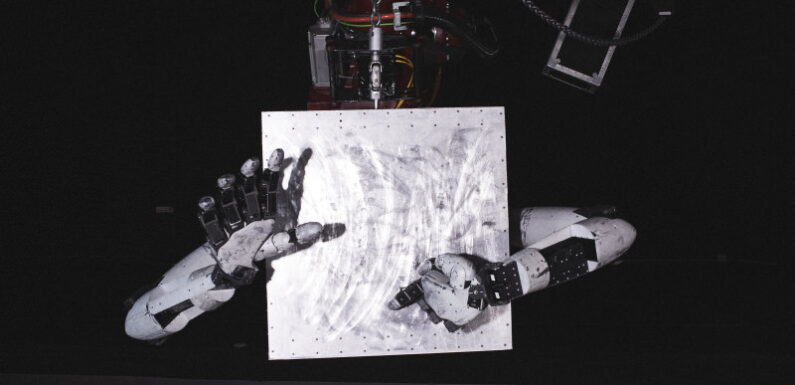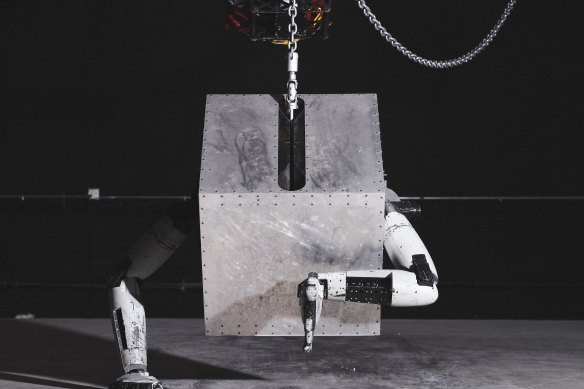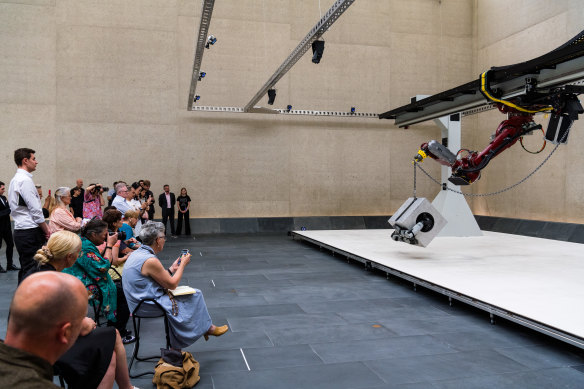
Save articles for later
Add articles to your saved list and come back to them any time.
Kiss Kiss Bang Bang. Jordan Wolfson’s Body Sculpture goes through an elaborate range of gestures in a half hour cycle, from the sexually suggestive to the suicidal. The National Gallery of Australia has invested $6.67 million in this work and waited five-and-a-half years for it to be delivered.
Conscious of the magnitude of the gamble he has taken, NGA director Nick Mitzevich tells us “Body Sculpture is a historic acquisition for the National Gallery, marking a milestone in contemporary art. As with other works in the national collection, it will continue to reverberate into the future.”
In the past, Mitzevich has suggested the piece is of comparable importance to Jackson Pollock’s Blue Poles. It’s a big rap for Wolfson, a 43-year-old New Yorker who has made an international reputation with large-scale animatronic sculptures and installations that dabble dangerously with sex and violence.
Jordan Wolfson’s Body Sculpture.Credit: David Sims
So what exactly does the Australian taxpayer get for $6.67 million? Answer: a large gizmo, 17.98 metres long, 4.29 metres high, with a depth of 11 metres. A rivetted metal cube is suspended on the end of a heavy chain, manipulated by a robotic device attached to a gantry. The cube itself spouts a pair of robot arms with which it caresses its surface; beats out a staccato, like a gorilla thumping its chest; makes the delicate gestures of a dancer; flaps its hands like wings; wags a finger at the viewer; and forms a mock gun, which it points at itself.
The robot crane lifts and lowers the cube, dragging it from left to right and back again. At one stage it has a tantrum and begins bashing the chain against a metal column.
Unlike Wolfson’s two previous animatronic sculptures, Female Figure (2014) – a masked woman in a dance costume, and Colored Sculpture (2016) – a leering Pinocchio doll, the new work is as featureless as a hunk of industrial machinery. The metal cube becomes a surrogate body through the movements of the robot arms, inviting the spectator to identify with the sensations it mimics.
Jordan Wolfson’s Body Sculpture on display at the NGA.
It’s by no means obvious what’s going on. After the cube rubs its “chest” for a while, it scrapes back and forth against the floor in sexual fashion. Wolfson refers to this as “the assault”, although there’s no apparent victim. When the cube points two fingers at its own “head”, at the end of the half-hour cycle, we are presumably expected to take this as remorse. I must stress, the chest and head are purely imaginary, as all we are seeing is a metal box with two agile appendages.
And that’s all folks! If this is the future of sculpture, the medium is in trouble. This mechanical pantomime, broken only by a few thumps and swooshes, may be “extraordinary” to some, but I suspect many viewers will find it dull fare.
I thought I was beyond the point of secretly wanting to be shocked by a work of contemporary art but watching Body Sculpture go through its paces I realised I’d been hoping for something a bit more outrageous, more challenging and provocative. By Wolfson’s usual standards this massive work is almost demure.
At first glance it looks as if this imposing pile of factory hardware might turn on the audience in the ultimate AI nightmare, but one soon realises that Body Sculpture is completely self-involved, a victim of its own pre-programmed choreography. Go along certainly, but don’t expect to be thrilled and titillated. There is nothing in this work more shocking than the price we paid for it.
Jordan Wolfson: Body Sculpture is at the National Gallery of Australia, Canberra until April 28.
Most Viewed in Culture
From our partners
Source: Read Full Article

